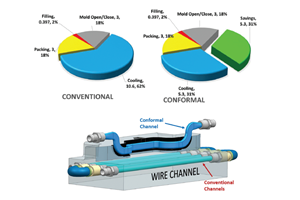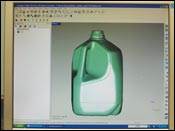Rebuilding Tools with High Performance Material
High-performance alloy offers a unique combination of thermal conductivity and strength—providing numerous benefits to the moldmaker and molding process.
MoldMAX, a high-performance alloy from Brush Wellman Inc. (Cleveland, OH), provides a unique combination of thermal conductivity and strength that yields important benefits for molders and the molding process. This high thermal conductivity results in shorter cycle times as the mold heats to operating temperature faster. Once the plastic is injected, it is able to reach a uniform temperature more quickly than with steel tools. This uniform cooling results in better part quality, decreased warping and greater part strength.
Without uniform cooling a number of concerns arise. Among them, resin characteristics are not maximized and the part does not have the level of ductility or rigidity necessary; stress is added to the material that causes the part to break or fail in the application; and, high temperature concentrations in ribbed areas and support structures cause part distortion as it cools outside the mold. Temperature concentrations cause gases to form in the mold due to the combination of heat, chemical composition of the resin and condensation. This can cause porosity in the plastic, degradation of the resin (causing it to discolor and not set up correctly), and corrosion to the core/cavity surface of the mold.
MoldMAX allows moldmakers to provide their customers with an alternative solution, which can lead to increased profitability through better machinability, cycle time reduction and part quality.
X Games Fly Box
Just as extreme athletes often seek faster speeds, the company that manufactures the popular X Games Fly Box skate/bike ramp sought faster cycles in molding the toy’s plastic components.
The Fly Box, manufactured by custom plastic injection molder, First Plastics Corp. (Leominster, MA) features two facing ramps supported by a middle tabletop. Assembled, it measures 24" wide by 96" long by 18" high.
According to First Plastics’ president, Ed Mazzaferro, F & M Tool (Leominster, MA) built a total of six tools for this project. These tools were made from P-20 steel. While the finished plastic pieces that were being produced were acceptable for use on the Fly Box, the surfaces showed signs of warping, which left a bumpy surface that was unattractive.
The surface of the table also had imperfections and the rib section on the underside caused distortion to the top. F & M rebuilt the single cavity tool for the 24" x 24" x 3" tabletop using MoldMAX LH®, which is specially designed for the plastic processing industry.
“This improved the look of the tabletop and eliminated the distortion. Cycle times were also reduced from 67 seconds to 40 seconds,” says Mazzaferro.
First Plastics was so pleased with the results of the MoldMAX part for the table, they decided to also rebuild the tools for the leg section using it. The leg mold has four cavities. The new MoldMAX part has nearly cut the cycle time in half, from 80 seconds to 46.
According to Mazzaferro, prior to retooling his company produced 1,000 finished units per week. Now due to these reductions in cycle time, they are producing 1,500 finished units each week—a 50 percent increase in productivity.
The company is eager to repeat these positive results and plans are currently underway to rebuild the ramp tools for even greater speed and efficiency.
|
High-Performance Alloy Designed for Plastic Processing MoldMAX copper mold alloys provide shorter cycle time, improved plastic part dimensional control, better parting line maintenance and excellent corrosion resistance. They provide strength and wear resistance similar to that of many tool steels. In addition, they offer a thermal conductivity up to 10 times greater than steel. It is typically specified for injection mold components and core/cavity inserts; blow mold pinch offs, neck rings and handle inserts; and, hot runner system injection nozzles and manifolds.
MoldMAX LH® (Low Hard) is a premium copper mold alloy that provides hardness and strength comparable with standard AISI P-20 tool steel and a thermal conductivity five times higher. It is used for injection mold cores and cavities where moderate hardness and high toughness and conductivity are required.
|
||||||||||||||||||||||||||||||||||||||||||
Related Content
How to Use Scientific Maintenance for More Accurate Mold and Part Troubleshooting
Discover how adopting scientific maintenance approaches helps improve mold lifespan, minimize failures, and optimize production outcomes.
Read MoreHow to Use Thermal Management to Improve Mold Cooling
A review of common mold cooling issues and possible solutions, including 3D printing applications.
Read MoreHow to Overcome Complex Mold Texturing Problems
Key benefits when considering laser technology for mold texturing and repair.
Read MorePortable Low-Heat, Non-Arcing Resistance Welder for Mold Repair
Rocklin’s user-friendly MoldMender Micro Welder delivers simple and cost-effective localized repair in-house with precision and versatility, enhancing mold and die durability and reducing disassembly and downtime.
Read MoreRead Next
Fast, Accurate Reverse Engineering Created Improved Product
A 3-D laser scanning project involving reverse engineering a blow molded bottle when no CAD data was available.
Read MoreHow to Use Strategic Planning Tools, Data to Manage the Human Side of Business
Q&A with Marion Wells, MMT EAB member and founder of Human Asset Management.
Read MoreAre You a Moldmaker Considering 3D Printing? Consider the 3D Printing Workshop at NPE2024
Presentations will cover 3D printing for mold tooling, material innovation, product development, bridge production and full-scale, high-volume additive manufacturing.
Read More
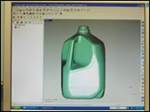


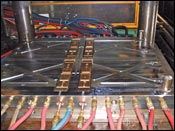
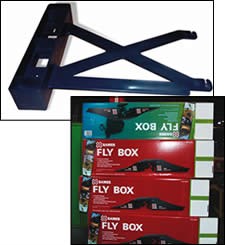










.jpg;maxWidth=300;quality=90)


